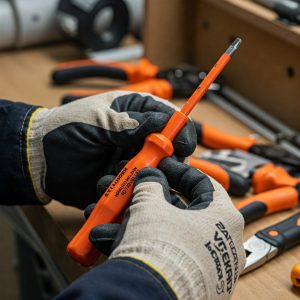Keep Your Shield Up: Essential Care & Maintenance for Insulated Tools
Date: May 7, 2025

Introduction
Insulated hand tools are more than just implements for a task; they are a critical line of defence, your personal “shield” when working on or near energised electrical equipment. While choosing high-quality, VDE/IEC 60900 certified tools is the first crucial step (as we discussed in our previous post), their protective properties are not infinite. Like any safety equipment, insulated tools require regular care and diligent maintenance to ensure they continue to offer the protection you rely on. This post will guide you through the essential practices to keep your insulated tools – and yourself – safe.
Why Maintenance Matters More Than You Think
It might seem straightforward, but the implications of neglecting insulated tool care are significant:
- Compromised Safety: The primary reason for using these tools is their insulation. Any damage – nicks, cuts, cracks, or contamination – can create a path for electrical current, effectively rendering the tool unsafe and exposing you to the risk of severe injury or fatality.
- Tool Longevity & Value: Properly maintained tools last longer. Protecting your investment means ensuring these specialised tools remain in service safely for their intended lifespan.
- Workplace Compliance & Professionalism: Many professional environments mandate regular inspection of safety equipment. Maintaining your tools demonstrates a commitment to safety standards and professional best practice.
The Pre-Use Inspection: Your Daily Lifesaver
Before every single use, a thorough inspection is paramount. Think of it as a quick but vital safety ritual:
- LOOK Carefully at the Insulation:
- Damage: Check meticulously for any nicks, cuts, deep scratches, gouges, cracks, peeling, or signs of brittleness in the insulating material. Pay extra attention to areas that experience more wear.
- Exposure: Is any part of the underlying metal tool visible through the insulation?
- Burns/Melting: Are there any burn marks, melted spots, or signs of charring? This indicates exposure to excessive heat, potentially compromising the insulation.
- Contamination: Look for signs of chemical attack or embedded foreign particles that could degrade the insulation.
- Markings: Are the 1000V rating and VDE certification marks still clear and legible?
- FEEL the Tool:
- Handle Security: Ensure the insulated handles are firmly attached to the metal part of the tool. There should be no looseness, twisting, or separation.
- Surface Integrity: Run a (gloved, if you prefer) hand over the insulation. Does it feel smooth, or are there any unusual textures or embedded materials?
- Function Check (The Tool Itself):
- Ensure the tool’s mechanical parts (jaws of pliers, screwdriver tips) are in good condition and function correctly. A damaged tool can lead to slips and accidental contact.
Crucial Rule: WHEN IN DOUBT, TAG IT OUT! If you have any suspicion that a tool’s insulation might be compromised, do not use it. Remove it from service immediately and mark it clearly as unsafe.
Cleaning Your Insulated Tools: Keep Them Pristine
Dirt, grease, and chemical residues can obscure damage and may even degrade insulating materials over time.
- What to Use: Clean tools with a soft cloth, mild soap, and water. Some manufacturers may approve specific cleaning agents – always check their recommendations.
- What to AVOID: Do not use harsh solvents, petrol, abrasive cleaners, or wire brushes on the insulated parts, as these can damage the protective layers.
- Dry Thoroughly: After cleaning, ensure tools are completely dry before storing them to prevent moisture issues.
Safe Storage: Protecting Your Protection
How you store your tools is just as important as how you use and inspect them.
- Prevent Physical Damage: Store insulated tools separately from uninsulated tools, sharp objects, or heavy items that could crush or gouge the insulation. Use dedicated tool rolls, pouches, foam-lined drawers, or wall-mounted racks.
- Control the Environment: Avoid storing tools in areas with extreme temperatures for prolonged periods. While VDE tools are tested for cold impact, consistent exposure to harsh conditions isn’t ideal. Protect from direct sunlight (UV exposure) and corrosive chemicals.
A Note on Re-Testing
Formal dielectric re-testing of insulated tools to verify their insulating properties requires specialised equipment and procedures. This is typically not performed by the end-user. For the professional tradesperson, diligent and regular pre-use visual and tactile inspection is the most practical and essential method for ongoing safety assurance.
Knowing When to Retire an Insulated Tool
There comes a time when an insulated tool, even a high-quality one, must be retired from service to ensure safety. Discard and replace tools if you observe:
- Any visible breach, crack, cut, or hole in the insulation that exposes the metal underneath.
- Loose, cracked, or damaged handles.
- Significant melted or charred areas on the insulation.
- Deep gouges that compromise the insulation thickness.
- Illegible 1000V or VDE certification markings.
- The tool has been subjected to severe mechanical abuse (e.g., used as a pry bar or hammer), even if the insulation appears intact, as underlying damage could have occurred.
Remember: Your safety is worth far more than the cost of a new tool.
Conclusion: A Continuous Commitment
Your insulated hand tools are a vital investment in your personal safety. Treating them with respect through regular inspection, cleaning, and proper storage is not just good practice – it’s a fundamental part of your professional responsibility. By “keeping your shield up,” you ensure your tools are always ready to protect you.
For tools built with safety and durability at their core, explore our comprehensive range of VDE-certified insulated hand tools – https://insulated-hand-tools.co.uk/shop/
